Spa Valley Railway
| Spa Valley Railway | |
|---|---|
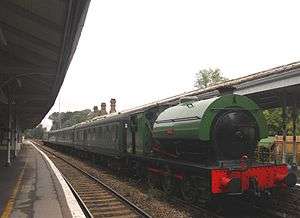 RSH 0-6-0ST No. 62 'Ugly' and train at Eridge | |
| Commercial operations | |
| Original gauge | 4 ft 8 1⁄2 in (1,435 mm) standard gauge |
| Preserved operations | |
| Length | 5.5 mi (8.9 km) |
| Preserved gauge | 4 ft 8 1⁄2 in (1,435 mm) standard gauge |
| Commercial history | |
| Closed | 1985 |
| Preservation history | |
| December 1996 | Re-open first 0.8 mi (1.3 km) from Tunbridge Wells West to near High Rocks |
| August 1997 | Open to Groombridge |
| 2005 | line to Birchden Jn open for special services |
| 25 March 2011 | Open to Eridge |
| Headquarters | Tunbridge Wells West railway station |
| Spa Valley Railway | ||||||||||||||||||||||||||||||||||||||||||||||||||||||||||||||||||||||||||||||||||||||||||||||||||||||||||||||||||||||||||||||||||||||||||||||||||||||||||||||||||||||||||||||||||||||||||||||
|---|---|---|---|---|---|---|---|---|---|---|---|---|---|---|---|---|---|---|---|---|---|---|---|---|---|---|---|---|---|---|---|---|---|---|---|---|---|---|---|---|---|---|---|---|---|---|---|---|---|---|---|---|---|---|---|---|---|---|---|---|---|---|---|---|---|---|---|---|---|---|---|---|---|---|---|---|---|---|---|---|---|---|---|---|---|---|---|---|---|---|---|---|---|---|---|---|---|---|---|---|---|---|---|---|---|---|---|---|---|---|---|---|---|---|---|---|---|---|---|---|---|---|---|---|---|---|---|---|---|---|---|---|---|---|---|---|---|---|---|---|---|---|---|---|---|---|---|---|---|---|---|---|---|---|---|---|---|---|---|---|---|---|---|---|---|---|---|---|---|---|---|---|---|---|---|---|---|---|---|---|---|---|---|---|---|---|---|---|---|---|
| ||||||||||||||||||||||||||||||||||||||||||||||||||||||||||||||||||||||||||||||||||||||||||||||||||||||||||||||||||||||||||||||||||||||||||||||||||||||||||||||||||||||||||||||||||||||||||||||
The Spa Valley Railway (SVR) is a standard gauge heritage railway that runs from Tunbridge Wells West railway station in Tunbridge Wells to High Rocks, Groombridge, and Eridge, where it links with the Oxted Line. En-route it crosses the Kent and East Sussex border, a distance of 5 miles (8 km), along the former Wealden Line between Tunbridge Wells Central and Lewes. The railway headquarters is at Tunbridge Wells West railway station.
History
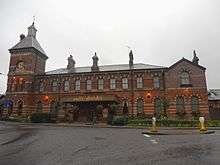
The railway was engineered by the London, Brighton and South Coast Railway's (LB&SCR) Chief Engineer Frederick Banister, as part of the East Grinstead, Groombridge and Tunbridge Wells Railway (EGGTWR), itself an extension to the Three Bridges to East Grinstead Railway which had been completed in 1855.
The EGGTWR was part of a regional race between the LB&SCR and the SER, and a specific race to access the town of Royal Tunbridge Wells:[1]
| “ | The LBSC was becoming concerned at threatened incursions by the [SER] on its territory. So a battle was on. Tunbridge Wells was first reached from East Grinstead in 1866 via Groombridge. Two years later, with the South Eastern Railway (SER) looking towards Lewes, the London, Brighton and South Coast Railway countered with a line from Groombridge to Uckfield. | ” |
The LB&SCR opened Tunbridge Wells West in 1866 as the eastern terminus of the EGGTWR; there was also an extension to Tunbridge Wells Central. From Tunbridge Wells West there were direct services to the South Coast at Brighton and Eastbourne and to London Victoria. The Victoria services ran via Groombridge and Ashurst. As a sign outside the station proudly proclaimed, "New Route to London: Shortest, Quickest and Most Direct. Frequent Express Trains."[2]
Closure
As the popularity of the motor car increased, train services were severely cut back due to the lack of patronage, and the number of services passing through Tunbridge Wells West declined as one line after another was closed from the 1950s onwards. First, the East Grinstead to Lewes line closed in 1958, then the Cuckoo Line in 1965, the Three Bridges to Groombridge in 1967, and finally the Wealden Line south of Uckfield in 1969. The line between Tunbridge Wells and Eridge was itself listed for closure in 1966, only to be subsequently reprieved. The line remained open, although in its latter years passenger services were mainly confined to a shuttle service between Tonbridge (via the single line connection to Tunbridge Wells Central - now plain Tunbridge Wells) and Eridge with a few through trains to Uckfield; however there was a depot at Tunbridge Wells West which housed rolling stock for services on the Uckfield and East Grinstead - London (via East Croydon) lines, and there were several empty stock moves early and late in the day.
Following a lack of investment for decades (since Beeching, spending on anything other than essential repairs was non-existent[3]), by the early 1980s the track and signalling needed to be replaced. British Rail, at the time carrying out an upgrade of the Tonbridge to Hastings Line which included the renewal of Grove Junction, decided that the cost of keeping the line from Eridge to Grove Jn open and undertaking the works, some £175,000, did not justify the outlay. It therefore announced the proposed closure of the line (including Groombridge and Tunbridge Wells West station) from 16 May 1983 which was later deferred after public objections. The Secretary of State for Transport agreed to the withdrawal of passenger services which took effect from 6 July 1985, although the section between Tunbridge Wells West and Birchden Jn remained open for rolling stock movements until 10 August, when the depot at Tunbridge Wells West station was shut.[4] At the time of closure Tunbridge Wells West station had gas lighting, which was in operation in the ticket office and under the canopy.
Preservation

Restoration
The Spa Valley Railway (SVR) has its origins in a charitable society formed on 13 September 1985, to purchase and reopen the Tunbridge Wells West to Eridge line. Named the Tunbridge Wells and Eridge Railway Preservation Society (TWERPS), it began a long struggle to reopen the line. The campaign received a setback in the late 1980s when Tunbridge Wells Borough Council gave planning permission for the construction of a large Sainsbury's supermarket complex on the site of the derelict goods yard of Tunbridge Wells West. While the 1891 locomotive shed and station building were protected as listed buildings, the remaining area of the site was obliterated, including the goods shed and signal boxes. However, planning permission was subject to the condition that the developer pay for construction of a new station platform and restoration of the engine shed.[5]
In 1996 the North Downs Steam Railway relocated from Dartford, where it was experiencing vandalism problems, and merged with TWERPS. It transferred its assets and helped establish a base in the former LB&SCR locomotive shed. Also in 1996, the group acquired the line as far as Birchden Junction. Alongside the loco shed a new platform was built, from where services began running to Cold Bath Bridge (about 0.8 miles (1.3 km) away) in December 1996. Services were extended to Groombridge in August 1997 and to Birchden Junction in 2005.
In 2007, SVR marked the 10th anniversary of the opening of the line by transforming Groombridge into a busy interchange station, with trains arriving or departing every 15 minutes.[6] The funds raised from this event went towards the "Return to Eridge" appeal to raise £500,000 for the extension to the Uckfield main line at Eridge. On 25 March 2011 the SVR extended passenger services to Eridge, where there is a footbridge interchange with Southern services on the London Bridge to Uckfield line.
In August 2017, a special event (20th Birthday Bash) was held to celebrate 20 years since the reopening of the line to Groombridge, starring a variety of home and visiting locomotives, including BR Standard 4 Tank 80078.
Operations
The SVR provides a way of getting to other local tourist attractions, such as Groombridge Place, High Rocks and the Pantiles in Tunbridge Wells.
The railway holds a number of special event days throughout the year including Day Out with Thomas weekends, Santa Specials, a summer diesel gala and also real ale and cider festival (jointly organised by CAMRA) which is combined with the railway's autumn diesel gala and held each October.
On regular Saturday evenings throughout the year a form of dining train service operates, these are either a Fish & Chip Supper, Murder Mystery or the lines High Weald Belle at seat dining service. The High Weald Belle is named after the countryside the railway passes through and allows passengers to enjoy a five course evening dining experience or on regular Sundays a three course roast dinner. These evening trains are also available for 'ordinary' passengers (although without the meal) to travel on, and therefore provide a means of transport for those who have spent the evening at the various public houses and venues along the line. The late trains prove popular particularly from Groombridge, where passengers can have an evening in the various pubs, and still get back to Tunbridge Wells or Eridge.
The railway operates from February to October as well as Tuesdays, Wednesdays & Thursdays in the summer months. In December the railway operates its popular Santa Special services up until Christmas and then runs selected days between Christmas and/including New Year's Day.
During November and January the line is usually closed to the public. This allows the railways infrastructure department time to carry out major track renewals such as installation of new point work, something that Groombridge and Tunbridge Wells West have both benefited from in recent times.
Future plans
There was an extensive, almost self contained, network of lines emanating from Tunbridge Wells until the late 60s. Eridge could provide a natural spring board for extensions to the operational railway. Although there are no published firm plans, the railway has a stated aim to protect the abandoned railway alignments, and it would not seem unreasonable that they may one day seek to extend the railway.
Most obvious would seem to be a southern extension towards Rotherfield on the former Cuckoo Line. Whilst such an extension would be exceptionally expensive, and require an immense amount of work, the Spa Valley has already proven itself more than capable of making the difficult or unlikely a reality.
In the medium term the railway is in need of carriage sidings and a larger maintenance depot for rolling stock. As passenger numbers and train frequency increases, so the need for a carriage depot increases too. The railway has a stated aim to "secure a site for a light maintenance depot" at some point along the line.
Rolling Stock
Operational Steam Locomotives
| Identity | Other Number(s) |
Railway | Class | Builder | Works Number |
Built | Wheel Arrangement |
Notes | Image |
|---|---|---|---|---|---|---|---|---|---|
| Ugly | 62 | Stewarts & Lloyds Ltd, Corby | Ugly | RSH | 7673 | 1950 | 0-6-0ST | Operational (February 2018)[7] | 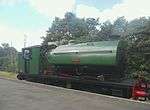 |
| ' | 52322 | Horwich Works | A | Lancashire and Yorkshire Railway | 52322 | 1896 | 0-6-0 | Operational. On hire until end of August 2018. | .jpg) |
Non-operational Steam Locomotives
| Identity | Other Number(s) |
Railway | Class | Builder | Works Number |
Built | Wheel Arrangement |
Notes | Image |
|---|---|---|---|---|---|---|---|---|---|
| 50 Sutton (originally Whitechapel) |
650, B650, 2650, W9, 515S, 32650 | LB&SCR | A1X (Terrier) | Brighton Works | 1876 | 0-6-0T | Under overhaul (2011-08-15)[8] |  | |
| 47493 | 16576, 7493 | LMS | 3F "Jinty" | Vulcan Foundry | 4195 | 1927 | 0-6-0T | Under overhaul (2014-01-09)[9] | 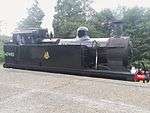 |
| 68077 | 8077, 14 | LNER | J94 | Andrew Barclay | 2215 | 1947 | 0-6-0ST | Stored (2006-09-06)[10] | 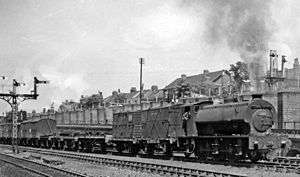 |
| 2315 Lady Ingrid |
South of Scotland Electricity Board, Braehead Power Station | Andrew Barclay | 2315 | 1951 | 0-4-0ST | Under overhaul (2009-9-28)[11] |  | ||
| No.57 Samson |
Stewarts & Lloyds Ltd, Corby | Ugly | RSH | 7668 | 1950 | 0-6-0ST | Stored (2008-01-22)[12] | ||
Operational Diesel Locomotives
| Origin | Wheel arrangement |
Class | Notes | Photograph |
|---|---|---|---|---|
| BR | 0-4-0DM | Vulcan Drewry Diesel Mechanical Shunter No.2591 Southerham | Operational (2017) | .jpg) |
| BR | 0-6-0DE | 10 | No. D3489 Colonel Tomline - BR black with Felixstowe Docks logos. In Service | 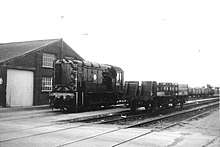 |
| BR | Bo-Bo | 33 | No. 33 063 R J Mitchell - Railfreight Mainline. In Service | |
| BR | Bo-Bo | 33 | No. 33 201. In Service | _(6136924271).jpg) |
| BR | Bo-Bo | 73 | No. 73 140 - Network South East. Built in 1966. | _at_Tunbridge_Wells_West_(1).jpg) |
Non-operational Diesel Locomotives
| Origin | Wheel arrangement |
Class | Notes | Photograph |
|---|---|---|---|---|
| BR | 0-6-0DE | 09 | No. 09 026 Cedric Wares - Entered preservation 22-05-16. | |
| BR | 0-6-0DE | 12 | No. 15224 (Only surviving member, stored awaiting major overhaul) | 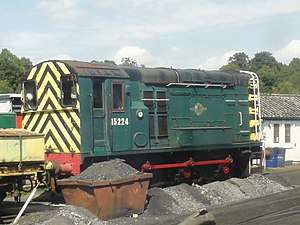 |
| BR | Bo-Bo | 33 | No. 33 065 Sealion BR Blue. Built in 1962. (Under overhaul) | |
Diesel Multiple Units
| Origin | Class | Notes | Photograph |
|---|---|---|---|
| BR | 101 | DTC no. 56408 (latterly renumbered 54408 in B.R. service) | 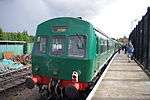 |
| BR | 115 | Unit 51669+51849 | |
| BR | 207 | Unit no. 1317 (207 017) (Only three-car unit in preservation - currently operating as two car unit) | _in_Tunbridge_Wells_West_Shed.jpg) |
Electric Multiple Units
| Origin | Class | Notes | Photograph |
|---|---|---|---|
| BR | 489 | Unit 9104 | |
| BR | 420 | Buffet Coach no. S69306, Used as a static cafe as Tunbridge Wells West station.[13] | |
| BR | 421 | 3CIG 1497. Leased July 2017 for 5yr period. To be used as coaching stock. | |
| BR | 6-PAN | TFK no. 12275 underframe only converted to crane wagon.[14] | |
Carriages
| Origin | Number | Type | Notes | Photograph |
|---|---|---|---|---|
| BR | S21214 | MK.I Brake Corridor Composite (BCK) | Operational, painted in BR Green. Overhauled 2017. | |
| BR | S25843 | MK.I Corridor Second (SK) | Operational, converted to Second Open with Buffet ("Kate"), painted in BR Green. | |
| BR | 25845 | MK.I Corridor Second (SK) | Operational, painted in BR Maroon. | |
| BR | S4828 | MK.I Standard Open (SO) | Operational, painted in BR Green. | |
| BR | 4999 | MK.I Tourist Second Open (TSO) | Operational, painted one side in Blue and Grey, other in BR Green. | |
| BR | S5037 | MK.I Tourist Second Open (TSO) | Under restoration, painted in BR Green. | |
| BR | 81432 | MK.I Gangwayed Full Brake | Stored | |
| BR | S9414 | MK.II Brake Second Open (BSO) | Under overhaul, painted in BR Green. |
References
- ↑ Oppitz, Leslie (2003). Lost Railways of Kent. Newbury, Berkshire: Countryside Books. p. 69. ISBN 978-1-85306-803-4.
- ↑ Oppitz, Leslie (2001). Lost Railways of Sussex. Newbury, Berkshire: Countryside Books. p. 74. ISBN 978-1-85306-697-9.
- ↑ Hughes, Stephen (March 1984). "'Brighton' Frontier: Requiem?". Railway Magazine. 130 (995): 89.
- ↑ Subterranea Britannica
- ↑ Kent Rail, Spa Valley Railway
- ↑ Kent and Sussex Courier, "Full steam ahead for anniversary", 14 September 2007, p. 21
- ↑ Dives, M (11 November 2011). "RSH Ugly Class No. 62 'Ugly'". Spa Valley Railway Website. Spa Valley Railway. Retrieved 22 April 2012.
- ↑ Dives, M (15 August 2011). "LB&SCR A1X Terrier No. 32650 Sutton". Spa Valley Railway Website. Spa Valley Railway. Retrieved 22 April 2012.
- ↑ Dives, M (19 January 2011). "LMS 'Jinty' No. 47493". Spa Valley Railway Website. Spa Valley Railway. Retrieved 22 April 2012.
- ↑ Dives, M (6 September 2006). "LNER J94 No. 68077". Spa Valley Railway Website. Spa Valley Railway. Retrieved 22 April 2012.
- ↑ Dives, M (28 September 2009). "Lady Ingrid". Spa Valley Railway Website. Spa Valley Railway. Retrieved 22 April 2012.
- ↑ Dives, M (22 January 2008). "RSH Ugly Class No. 57 'Samson'". Spa Valley Railway Website. Spa Valley Railway. Retrieved 22 April 2012.
- ↑ "VCT". Vintage carriages trustWebsite. Vintage Carriages trust. 29 July 2016. Retrieved 29 July 2016.
- ↑ "VCT". Vintage carriages trustWebsite. Vintage Carriages trust. 29 July 2016. Retrieved 29 July 2016.
External links
| Wikimedia Commons has media related to Spa Valley Railway. |